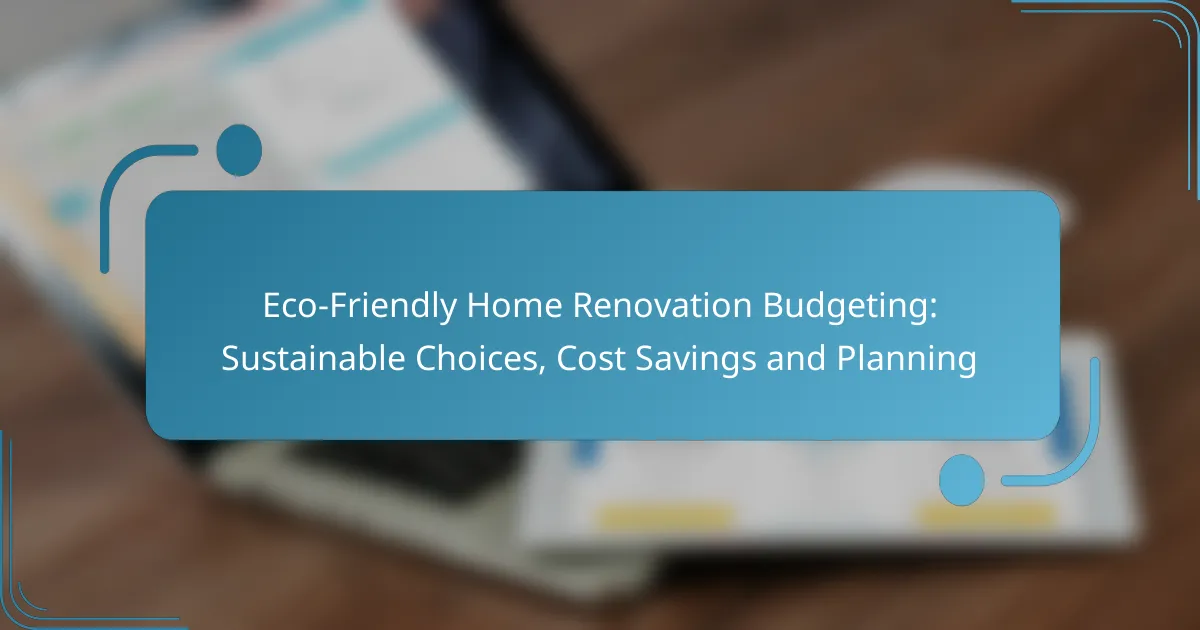Home renovations can be a significant financial undertaking, but with the right budgeting strategies and cost-saving measures, homeowners can achieve their desired upgrades without overspending. By prioritizing essential projects, leveraging local discounts, and selecting cost-effective materials, you can enhance your home’s value while keeping expenses in check. Careful planning and a focus on DIY tasks can further contribute to substantial savings, making your renovation journey both rewarding and economical.

How can I save on home renovation costs in Los Angeles?
To save on home renovation costs in Los Angeles, consider leveraging local discounts, negotiating with contractors, and tackling minor projects yourself. These strategies can significantly reduce expenses while maximizing the value of your renovations.
Utilize local discounts and promotions
Los Angeles offers various local discounts and promotions that can help you save on renovation costs. Check with home improvement stores for seasonal sales, loyalty programs, and bulk purchase discounts. Additionally, local contractors may offer promotions for first-time clients or during off-peak seasons.
Consider signing up for newsletters from local suppliers and retailers to stay informed about special deals. Websites like Groupon or local community boards may also list promotions from contractors and service providers.
Negotiate with contractors
Negotiating with contractors can lead to significant savings on your renovation project. Always obtain multiple quotes before making a decision, as this gives you leverage in discussions. Don’t hesitate to ask for discounts or to negotiate terms, especially if you are willing to pay in cash or can offer a flexible timeline.
Be clear about your budget and expectations, and ensure that all agreements are documented. This can help prevent misunderstandings and ensure that you receive the best value for your investment.
DIY projects for minor renovations
Taking on DIY projects for minor renovations can drastically cut costs. Simple tasks like painting, landscaping, or installing fixtures can be done with minimal tools and skills. Online tutorials and workshops can provide guidance, making these projects accessible even for beginners.
However, be mindful of your limits. For more complex tasks, such as plumbing or electrical work, it may be safer and more cost-effective to hire a professional. Assess the potential risks and benefits before diving into any DIY project.

What budgeting strategies should I use for home renovations?
Effective budgeting strategies for home renovations involve careful planning, prioritization, and financial foresight. By creating a detailed budget, focusing on essential renovations, and setting aside a contingency fund, homeowners can manage costs while maximizing the value of their investments.
Create a detailed renovation budget
Start by listing all potential renovation projects and their estimated costs. Break down each project into specific tasks, materials, and labor expenses to gain a clearer picture of the overall budget. For example, a kitchen remodel might include cabinets, countertops, appliances, and installation fees.
Consider using budgeting tools or spreadsheets to track expenses and compare them against your estimates. This will help you identify areas where you might overspend and allow for adjustments as needed. Aim to categorize costs into fixed and variable expenses to better manage your finances.
Prioritize essential renovations
Identify which renovations are necessary for safety, functionality, or compliance with local regulations. For instance, updating electrical systems or fixing plumbing issues should take precedence over cosmetic upgrades like new paint or decor. This approach ensures that your budget addresses critical needs first.
Once essential renovations are identified, rank them based on urgency and impact. This prioritization helps allocate funds effectively and may lead to a more satisfactory outcome. For example, if you have a limited budget, focus on renovations that significantly enhance your home’s value or livability.
Set aside a contingency fund
A contingency fund is crucial for managing unexpected expenses during renovations. Financial experts recommend setting aside about 10-20% of your total renovation budget for unforeseen costs, such as structural repairs or price increases in materials. This buffer can prevent financial strain and project delays.
To establish your contingency fund, calculate your total estimated renovation costs and set aside the recommended percentage. Keep this fund separate from your main budget to avoid spending it on non-essential items. Regularly review your expenses to determine if you need to adjust the contingency amount as the project progresses.

What are the most cost-effective materials for renovations?
Cost-effective materials for renovations include options that provide durability and aesthetic appeal without breaking the bank. Selecting the right materials can significantly reduce overall renovation costs while enhancing the value of your home.
Use reclaimed wood for flooring
Reclaimed wood is an environmentally friendly choice that adds character to your home. Sourced from old buildings or furniture, it often costs less than new hardwood while providing a unique look.
When considering reclaimed wood, check for quality and ensure it has been properly treated to avoid pests. Prices can vary, but expect to pay around 20-50% less than new hardwood options.
Opt for laminate countertops
Laminate countertops are a budget-friendly alternative to natural stone or solid surface materials. They come in various styles and colors, allowing you to achieve the desired look without the high cost.
Typically, laminate countertops can cost between $20 to $50 per square foot, significantly less than granite or quartz. Ensure you choose a high-pressure laminate for better durability and resistance to scratches.
Choose energy-efficient appliances
Energy-efficient appliances can save you money on utility bills while providing modern features. Look for appliances with the ENERGY STAR label, which indicates they meet energy efficiency guidelines set by the U.S. Environmental Protection Agency.
While the initial cost may be higher, the long-term savings on energy bills can offset this expense. For example, energy-efficient refrigerators can save you around $100 annually compared to standard models. Consider the total cost of ownership when selecting appliances for your renovation.

How can I increase my home’s value through renovations?
Increasing your home’s value through renovations involves strategic upgrades that appeal to potential buyers and enhance functionality. Focus on areas that yield the highest return on investment, such as kitchens, bathrooms, and curb appeal enhancements.
Focus on kitchen and bathroom upgrades
Kitchen and bathroom renovations typically offer some of the best returns on investment. Upgrading appliances, countertops, and fixtures in the kitchen can significantly enhance its appeal, while modernizing bathrooms with new tiles, vanities, and efficient plumbing can attract buyers.
Consider budgeting between 10-20% of your home’s value for these upgrades. Prioritize quality materials and timeless designs to ensure longevity and broader market appeal.
Enhance curb appeal with landscaping
Improving your home’s curb appeal through landscaping can make a strong first impression. Simple actions like planting flowers, maintaining the lawn, and adding decorative elements can increase perceived value.
Investing around 5-10% of your home’s value in landscaping can yield significant returns. Focus on low-maintenance plants and clear pathways to enhance visual appeal without excessive upkeep.
Add energy-efficient windows
Installing energy-efficient windows can improve your home’s energy performance and aesthetic appeal. These windows reduce energy costs and can be a selling point for environmentally conscious buyers.
Expect to spend about 15-20% of your renovation budget on window upgrades. Look for windows with a good Energy Star rating to ensure efficiency and compliance with local building codes.

What are the common pitfalls in home renovation budgeting?
Common pitfalls in home renovation budgeting include miscalculating expenses, overlooking hidden costs, and making design choices that don’t align with the neighborhood. These mistakes can lead to overspending and reduced property value, making it essential to plan carefully.
Underestimating costs
Underestimating costs is a frequent mistake in home renovation budgeting. Homeowners often focus on material prices without considering labor, permits, and unexpected expenses. It’s advisable to add a buffer of around 10-20% to the initial budget to account for these potential overruns.
To avoid this pitfall, create a detailed list of all anticipated expenses, including materials, labor, and additional fees. Regularly review and adjust this list as the project progresses to stay on track.
Ignoring hidden expenses
Hidden expenses can significantly impact the overall budget if not accounted for. These may include costs for permits, inspections, or even temporary housing if the renovation disrupts living conditions. Homeowners should research local regulations and factor in these potential costs early in the planning process.
Consider creating a checklist of common hidden expenses, such as utility upgrades or landscaping adjustments, to ensure nothing is overlooked. This proactive approach can help maintain control over the budget.
Over-customizing for the neighborhood
Over-customizing a home can lead to a mismatch between the property’s value and the neighborhood’s market. Unique features may not appeal to potential buyers, making it harder to recoup renovation costs. It’s crucial to strike a balance between personal taste and market trends.
When planning renovations, research similar homes in the area to gauge what features are desirable. Aim for improvements that enhance the home’s appeal without straying too far from the neighborhood’s style and price range. This strategy helps ensure that renovations add value rather than detract from it.








